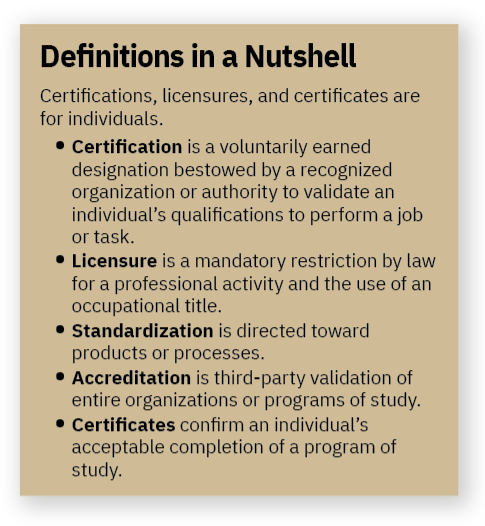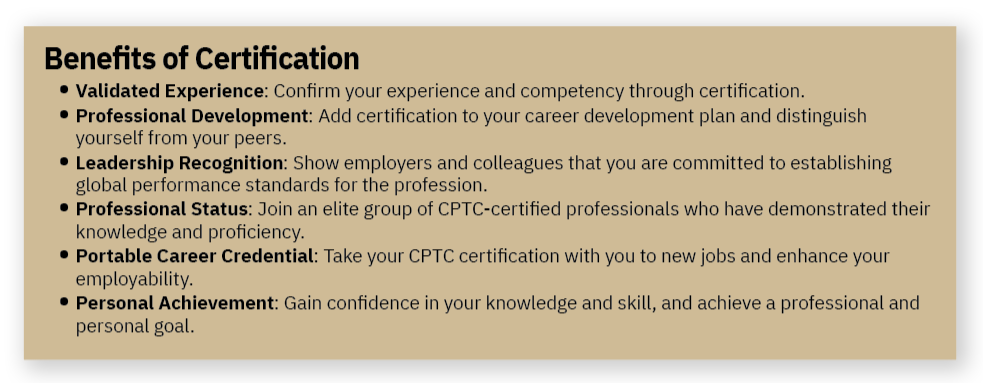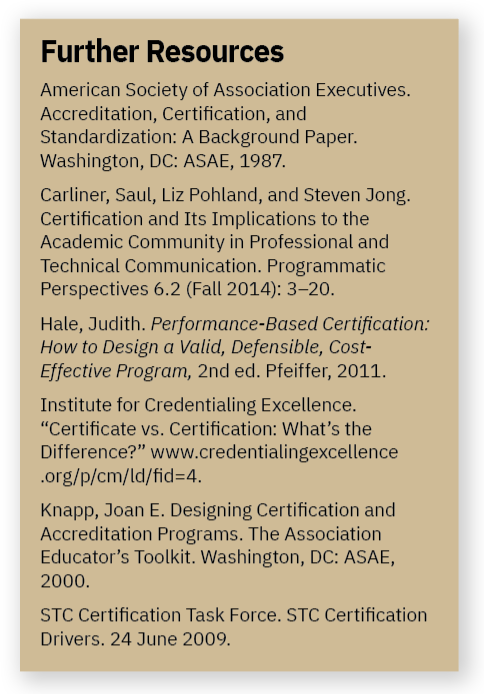This article is a revision of “Certification and STC’s Certified Professional Technical Communicator: What You Need to Know” by Liz Pohland and Chris Lyons, first published in Intercom in January 2016.
Considering earning professional certification? This article compares certification against other types of professional development credentials; explains the purpose and significance of certification; and gives important details on how candidates can prepare, earn, and maintain a professional credential.
What Is Certification?
The terms certification, licensure, standardization, accreditation, and certificate are sometimes used interchangeably. Although they are used this way in the vernacular, there are important distinctions between the definitions of each type of credential.
Certification is a voluntary process by which a nongovernmental agency or association grants recognition to individuals who have met certain predetermined qualifications of professional competence specified by that agency or association upon an assessment. Such qualifications may include acceptable performance on a qualifying examination and/or completion of some specified amount or type of work experience in the field.
There are three general types of certifications with varying degrees of development and portability—corporate (internal), product- or tool-specific, and profession-wide. Examples of corporate (internal) certifications include IBM Certified Support Professional, Oracle Database Certified Professional, and Apple Certified Support Professional. These certifications are less portable to other jobs or opportunities than the other two certification types. Examples of product- or tool-specific certifications include Adobe Certified Professional/Expert/Master, AWS Cloud Practitioner, and Microsoft Office Specialist. Examples of profession-wide certifications include STC’s Certified Professional Technical Communicator, the American Medical Writers Association’s Certified Medical Writer, and the Project Management Institute’s Project Management Professional.
Licensure is the process by which a government agency grants permission to individuals to engage in a given profession or occupation by certifying that those licensed have attained the minimal degree of competency necessary to ensure reasonable protection of the public’s health, safety, and welfare. Licenses are usually justified to regulate an activity whose incompetent execution would be a threat to the public, such as performing surgery or driving motor vehicles. Examples of workers who need licenses to do their work include board certified doctors, lawyers who have been admitted to the bar, commercial driving licensed truck drivers, and airline transport pilot licensed plane captains.
Standardization is the process by which a product or service is assessed against standards and specifications, such as the UL Solutions seal on electrical fixtures or internal audits done by companies that want to show compliance to national or international standards, such as those issued by the American National Standards Institute and the International Organization for Standardization (ISO). For example, in 2019, ISO released ISO 20607, a standards document that specifies requirements for machine manufacturers to prepare the safety-relevant parts of an instruction handbook for machinery.
Accreditation is the process whereby an accrediting agency grants public recognition to a school, institute, college, university, or specialized program of study for having met certain established qualifications or standards, as determined through initial and periodic evaluations. Regional accreditors typically focus on academically oriented, state-owned, or not-for-profit institutions (like the University of Pittsburgh). National accreditation generally covers niche institutions: for example, faith-based or single-discipline colleges (like an art school). Programmatic accreditation, as its name implies, is reserved for specific degree programs, such as engineering, accounting, education, nursing, and others focused on regulated professions. The U.S. Department of Education maintains a database of accrediting agencies it recognizes.
Certificates are commonly confused with certifications, but they are very different. A certificate recognizes completion of a defined program of study (such as a certificate for a software class completion), usually involving a combination of class attendance/participation, assignments, and/or an exam. Certificates are awarded to recognize mastery of specific learning outcomes provided by instruction and training. In contrast, certifications award designations to recognize professional achievements from knowledge, skills, and competencies previously acquired. Examples of certificates include short-term programs of study—such as the certificate courses offered by STC and other private training and development organizations like Coursera and Learning Tree International—and programs of study involving completion of multiple courses—such as certificate programs in technical communication offered by the continuing education departments of many colleges and universities.

Why Do Organizations Certify Individuals?
Any organization can consider creating a certification program for a particular skill or knowledge of an industry or field. Organizations may consider a certification program if: 1) they have a measurable business need to formally validate an individual’s knowledge or skill with or in a particular product, tool, or content area; 2) there are no tests or credentials available from other organizations to measure performance, knowledge, or skills with or in a particular product, tool, or content area; and 3) verifying a minimum performance capability of an individual is critical to the job (e.g., for safety, health, environmental, or other risk-related concerns).
One of the tasks in designing a certification program is to find a valid driver—a problem worth solving. The first reason most organizations certify focuses on recognizing a professional’s accomplishments and improving work processes. Organizations certify individuals to protect the public, confirming that practitioners have or can get the knowledge and skills required to do their jobs safely, efficiently, and effectively. They also certify to validate or enhance the stature of a role or position, to promote continuous improvement, to increase productivity, and to maintain skills and knowledge. Hiring organizations want a certified workforce so they can attract and retain competent staff, establish uniform performance standards to rapidly deploy workers, raise the level of core competencies, create multidisciplinary jobs, and comply with local and international standards.
Since professional certification confirms or validates knowledge or performance capability, it is important that the certifying organization also be recognized as an appropriate body to determine and grant professional certification. This is often a leading or generally recognized, active organization for professionals in a field. A professional certification created by an individual, an unknown association, or a just organized group would lack credibility.
What Does Certification Mean to Organizations and Businesses?
Businesses benefit from certification because it provides them with a benchmark to compensate, measure, and evaluate employees’ skills for roles within the organization. Teams are trained to consistent skills levels. Research by a variety of organizations—including Microsoft, IDC, CompTIA, and Novell—have shown that certified people are typically more productive and work to consistent standards. Certification ensures that knowledge has been retained, and it also results in greater customer satisfaction (internal and external customers) and lower staff turnover.

Do You Need a Certification?
Some employers require a certification in order to apply or qualify for a job. It’s a key item that hiring employers look for on résumés. Many people earn specialty certifications to help them advance in their careers.
A certification may also help you get promoted or earn more money than your co-workers who do not have the specific credential at hand.
Some industries are more likely to require certifications than others. According to data from the U.S. Bureau of Labor Statistics (BLS), the following occupations had the highest percentages of workers who held certifications but no licenses:
- Computer and mathematical (6.6%)
- Community and social services (4.6%)
- Installation, maintenance, and repair (4.1%)
- Business and financial operations (3.3%)
- Legal (3.3%)
- Health care practitioners and technical (3.1%)
The BLS’s CareerOneStop Credentials Center publishes a certification finder tool where you can search by job title or certification name. You can also narrow the search by industry or occupation.
What Does Certification Mean to Professional Technical Communicators?
The chief benefit of certification is simple: a certification program creates a preference in the job market for people who have taken the time to invest in themselves—in their skills and experience. For individuals in particular, becoming certified can be invaluable because it provides portable proof of your abilities and a robust understanding of the knowledge and specialized skills that are necessary to perform with a high degree of competence in a field. In every profession, certification helps employee, employer, and the consumer.
Employees benefit from professional certification in several ways:
- Validation of an employee’s skills and knowledge by a third party. In the case of the Certified Professional Technical Communicator credential, STC provides that validation. Additionally, STC is working with a third-party certification advisory group whose accreditation processes follow ISO standards. For the employee, STC’s Certified Professional Technical Communicator certification with accompanying requirements for continuing education is a professional milestone that carries weight and credibility among peers, clients, and organizational leaders.
- Differentiation from others in the marketplace, increased employment value, and the ability to command higher pay. Professional certification is an important credential on a résumé and provides evidence of qualifications. It denotes a level of competency and is an indicator of commitment, value, and quality performance and output. Obtaining certification may be a requirement for advancement, a means for keeping up with ever-changing technologies and processes, or a way of standing out from peers or competitors and commanding higher pay or more responsibilities.
- Engagement and commitment to the field. On a personal level, the certification process and requirement for annual training forces the practitioner to stay current, work on multiple types of jobs, learn new skills, and network with peers. It provides employees with clear evidence of an engagement and commitment to technical communication.
The companies that technical communicators work for also benefit in the following ways from employees who are certified:
- Validation of an employee’s skills and knowledge by a third party. Professional certification provides a quality marker that helps an employer gauge the effectiveness and qualifications of a potential hire. It reduces risk and simplifies the search through validation of knowledge and by providing a hiring baseline. When professional certification is a requirement in a job posting, it greatly focuses the candidate pool. Since the employer is depending on an independent validation to verify a candidate’s skill, it is important that the certification is granted by an established and credible organization, such as STC.
- Differentiation from others in the workforce. Employers want their hires to stay current and continue to grow in the profession. Professional certification programs provide milestones for employees, and after completing a certification qualification, remain a driver of continuing education and training. Employers can use achievement of professional certification as a requirement for advancement or pay increases as well.
- Engagement and commitment to the field and the business. Certified professionals with proven knowledge and competency will contribute more to an organization. They may be faster or more accurate workers, and they may be more creative or insightful in solving related business problems. And certified employees provide evidence that an organization’s technical communication team is more qualified than that of its competitors. Finally, businesses that support certification as an employee professional development benefit are more likely to retain employees for longer tenure with the company.
What Does Certification Mean to Consumers and Product Users?
With certified professionals in the workforce, the consumer is better off as well. Knowledgeable workers result in better products and superior communications: instructions are more easily understood, warnings are relayed properly, descriptions are complete, content can be reused, and the device used to access the content doesn’t limit the user. For technical communicators, professional certification sets a standard for skills, knowledge, and performance across the field of content work and information products. Ultimately, developing a well-thought-out certification program helps an organization’s employees, customers, and members advance the organization’s interests, as well as their own. It is arguably the best way to create confidence in the marketplace.

STC’s Certified Professional Technical Communicator (CPTC)
The Society for Technical Communication is fulfilling one of its mandates as a 501(c)(3) not-for-profit association by sponsoring professional certification for technical communicators. STC first launched a certification program for technical communicators in 2011. The goal behind the program was to create preference in the marketplace for certified technical communicators and to validate efforts in learning core skills, best practices, and specific industry standards. STC believes that certification is a powerful tool for driving market recognition and adoption of an essential skill set.
Per a report written in June 2009 titled “STC Certification Drivers,” the STC Certification Task Force identified the following driving factors for a certification program for technical communicators:
- Establish uniform worldwide performance standards.
- Increase employability and salaries of certified practitioners.
- Satisfy employer expectations.
- Reduce employer risk.
STC’s Certified Professional Technical Communicator (CPTC) program is a three-tiered professional certification: Foundation, Practitioner, and Expert.
- The Foundation-level Professional Certification focuses on knowledge and comprehension of the field. To achieve the Foundation CPTC designation, applicants must demonstrate knowledge and understanding of best practices in technical communication by passing an exam based on a body of knowledge, the Technical Communication Today textbook. Foundation CPTCs are informed members of a technical writing or a technical communication team within their professional work or in their organization.
- The Practitioner-level Professional Certification validates mastery of applying best practices and leading others in their appropriate use. Practitioner CPTCs have achieved sufficient understanding of how to apply and analyze technical communication guidance in a given organizational communications situation via a scenario-based test.
- The Expert-level Professional Certification demonstrates the candidate’s ability to evaluate and synthesize information via an assessment and requires submission of a set of work products, interviews with subject matter experts (SMEs), and a formal presentation.
To build the CPTC certification, STC partnered with APMG International, an ISO-accredited certification body that is an independent third party that coordinates the certification process with STC’s appointed chief examiner. ISO-certified bodies ensure that each certifying business follows ISO standards. Visit the APMG website at http://www.apmg-international.com/en/qualifications/CPTC/CPTC.aspx to learn more about the program or to register for the exams.

 LIZ POHLAND (liz.pohland@stc.org) is the Chief Executive Officer of STC.
LIZ POHLAND (liz.pohland@stc.org) is the Chief Executive Officer of STC.


